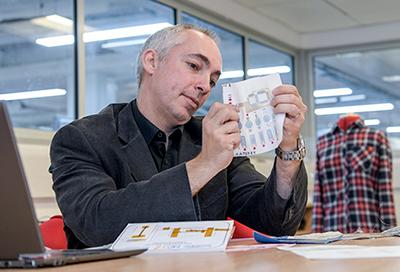Southampton researchers investigate smart fabrics capable of changing colour and controlling infections

Researchers from the University of Southampton are developing colour changing and antibacterial textiles that will inspire wide-ranging functional materials of the future.
The multi-disciplinary research which combines the Synthesis, Catalysis and Flow group in the School of Chemistry with the Smart Electronics and Materials (SEMS) group in Electronics and Computer Science (ECS) is investigating a new technique for achieving light emitting textiles which could be used in medical, performance sports, automotive, architecture and fashion applications.
The new project, funded by the Engineering and Physical Sciences Research Council (EPSRC), is formulating light emitting films on the surface of standard textiles through electronically functional inks and spray coating, along with cutting-edge inkjet and dispenser printing processes.
Professor Steve Beeby, Head of SEMS and Principal Investigator, says: “Textiles are demanding substrates for device printing due to their rough surface topology, porosity and the necessary low processing temperatures. The achievement of suitable functional materials along with reliable, consistent fabrication processes will enable a huge range of new textile products.”
The research is investigating the fabrication of textile organic light emitting electrochemical cells (OLECs) that can selectively operate at visible and UV wavelengths, representing a step change in e-textile capability. OLECs are electrochemically stable in air, require a low turn on voltage and have demonstrated a high luminance level, allowing them to be clearly visible in everyday lighting.
The use of UV-OLEC technology will enable photochromic colour-changing textiles capable of fast colour change, low operation voltage and power consumption, with a more diverse choice of colours and a clearer, more pronounced, change in appearance. UV-OLECs will also support textiles to perform ultraviolet germicidal irradiation (UVGI), which is a disinfection method that uses short wavelength UVC light. Textile based UVGI can be incorporated into medical applications such as smart bandages to treat or prevent infection and reduce reliance on antibiotics.
Co-Investigators Professor David Harrowven from Chemistry and Dr John Tudor from ECS are drawing upon their complementary expertise in the chemical synthesis of complex molecules and in e-textiles, printed devices, materials processing and formulation.
The SEMS group at Southampton has coordinated two EU projects worth a combined €12m over the last nine years, integrating electronic and sensing functionality in e-textiles. Similarly, over the past decade the Synthesis, Catalysis and Flow group has been the primary UK partner on two EU projects worth €11m and currently leads the 2017 European Regional Development Fund (ERDF) supported LabFact project (€6m). In addition, the group leads the Innovate UK collaborative project Chemo-enzymatic Production of Specialty Glycans (£3.5m) and is a partner on the EPSRC Programme Grant Photo-Electro: Transforming Chemical Synthesis, Discovery and Manufacture (£6.5m).